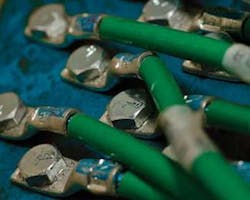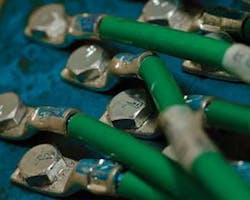Grounding and bonding questions answered
An online seminar yielded numerous real-life questions; an industry expert provides answers.
by John Carnevale
On September 27, Cabling Installation & Maintenance hosted an online seminar on the topic of grounding and bonding communications cabling systems. The seminar was sponsored, and technical presentations were delivered, by Panduit Corp. (www.panduit.com), Siemon (www.siemon. com), and Tyco Electronics/AMP Netconnect (www.ampnetconnect.com).
Following the three technical presentations, the lines were opened for a question-and-answer session. Because of the seminar’s 90-minute time limit, not all of the audience’s questions were addressed live. In this article, Panduit’s representative in that seminar, John Carnevale, provides answers to several questions from the audience.-Ed.
Q:If all equipment racks, ladder racks, etc., are bolted together, is it sufficient to simply attach a ground somewhere on a piece of ladder rack or equipment rack?
A: No; do not rely on incidental contact. You must make good, solid connections to each equipment/ladder rack and connect to a grounding infrastructure, such as the designated grounding bar or supplemental grounding structure commonly found under a data center access floor. Follow the J-STD-607-A and TIA-942 standards and place a grounding bar in each data center, telecommunications room, etc. Avoid placing grounding bars on exterior walls, and try to keep them close to the center of the building along the telecommunications bonding backbone (TBB). Also, try to keep the busbar close to the AC (alternating current) panel feeding the area, because you will need a connection to it.
Q: I have heard electricians say that some of the grounding in our facility may have a different frequency than the building ground. What does that mean? Isn’t a ground a ground?
A: The grounding system could be picking up noise in different parts of the building, from building power systems and from harmonics generated at nearby locations to the building. If you were to look at the frequencies on the grounding system at your entrance facility (where your main ground enters the building), you could see a spectrum of frequencies that may have been collected at different parts of the building. This is OK if they do not cause substantial interference problems within the building. Having too much current on the grounding system-causing heat, arcing, and electromagnetic interference-is something to worry about because it may indicate, for example, a problem of current leaking from some device within the building.
Q: According to J-STD-607-A, bonding conductors “shall be green,” but I cannot find a plenum-rated green #6 AWG stranded cable. What should be used in plenum spaces?
A: Use bare wire in plenum spaces and for building your grounding grid in an access floor. You can use insulated cable for a short distance when you go from the rack/cabinet down into the access floor. Use a UL, VW-1 flame-rated cable per the TIA-942 standard in this case.
Q: Per J-STD-607-A, if the TBB is greater than 66 feet, AWG 3/0 must be used. So, how do I retort the question: “What’s the point of using 3/0 when it eventually ends at the AWG-6 grounding electrode conductor?”
A: The point is that the TBB sizing is constructed to account for voltage drop (substantial equalization) between different floors. The grounding electrode system holds the TBB at local building ground.
Q: If I have an armored fiber-optic cable, must I bond it?
A: It depends. If it enters from the outside plant (OSP), the armor must be handled as an entering OSP cable shield per the National Electrical Code and telephone standards. If it originates within and stays within the same building, and is not “electrically exposed,” bond the armor to the grounding system. If the cable enters an enclosure or rack, you can bond the armor to it. The enclosure or rack should be grounded. The primary concern is to unintentionally pipe OSP influences directly into the enclosure or rack without first accounting for electrical protection.
Q: Does LAN equipment, such as switches, need to be grounded to busbars?
A: LAN equipment, such as switches, should be grounded per the manufacturer’s installation instructions. If the rack or cabinet that the LAN equipment is mounted within is properly grounded to the telecommunications grounding busbar (TGB), then the LAN equipment could be bonded to the equipment rack.
Q: What is the best, or most accurate, way to test bonding and grounding systems?
A: Testing of the bonding and grounding system should always include a visual inspection of the system. Inspect all connections for proper installation and to ensure all required connections are in place. Within the data center or telecommunications room environment, continuity and resistance measurements should be made from the TGB to racks, cabinets, and network equipment. An inherent testing problem arises from having multiple grounding/bonding connections in parallel such that it becomes difficult to ensure the item you test is indeed just that item. Typically, poor connections show a visible degradation, such as looseness or corrosion.
Q: Does every section of cable tray have to be grounded independently back to the TGB?
A: Each section of a cable tray needs to be grounded; however, an independent connection back to the TGB for each section is not required. In a telecommunications room, typically a grounding conductor wire is run parallel to the tray. Each tray section is then bonded to the wire with a mechanical connector. The end of the ground conductor wire is then bonded to the TGB. Alternatively, some manufacturers provide as part of their product installation a way to bond sections directly together, eliminating the need for a separate conductor wire. Always follow the manufacturer’s recommendations on bonding and grounding the cable tray. Look for more information in upcoming standards/practices revisions from the Telecommunications Industry Assocition (TIA) and BICSI.
Q: Do all modern RJ-45-style jacks on patch panels, equipment, network interface cards (NICs), etc., contain a contact to work with a shielded RJ-45 connector so the cable shields will be properly grounded?
A: All NICs and telecommunications equipment have shielded RJ-45 jacks. Some devices, such as Voice over Internet Protocol (VoIP) phones, do not have shielded RJ-45 jacks-but the jacks are double-insulated plastic and meet applicable guidelines. Patch panels that are designed to accept shielded jacks also allow for proper bonding of the jack to it. It’s important to understand that in those instances in which the device at the workstation does not contain a shielded jack, the integrity of the bond of the shield-to-ground is still maintained at the patch panel. Do not overlook the fact that shield continuity at 360° termination along the cabling path between transceivers is just as important as the grounding.
Q: I have heard discussion and debate about whether or not building steel is sufficient for bonding the telecommunications infrastructure. What’s the real story?
A: There is indeed discussion on the topic. In fact, this same debate raged during the initial draft process for the J-STD-607 standard, which preceded 607-A. When all was evaluated, the telecommunications bonding backbone (TBB) of copper was recommended over simply using building steel. The drafting group for 607-A maintained that position. Building steel construction is typically not specified to ensure electromagnetic interference-control quality of interconnections. That is one of several reasons the copper TBB is recommended. An exception occurs when the building steel is indeed specified, constructed, and tested to properly function over its entire life. Even then, the permeability factor in steel causes it to function approximately 10 times worse than copper when considering surge transient time. Because it is not possible to know how a building will be configured throughout its existence, or to accurately predict the grounding needs of future information technology equipment, good network grounding design in a new facility includes a TBB. The cost of installing this cable typically is minor compared to the cost of the equipment you are trying to protect and the cost of any downtime experience.
John Carnevale is product development manager within Panduit Corp.'s grounding group (www.panduit.com).

